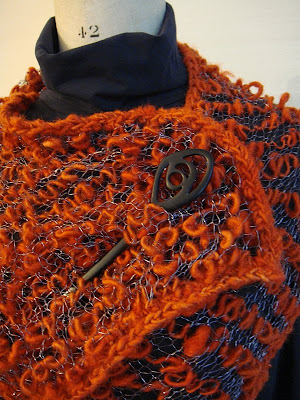A hat it became, a pattern out of a Japanese Let's knit magazine from 2007 (ISBN 978-4-529-04462-2). An original design, having not been knitted in the round and with two fan-like side pieces:
Un bonnet était le résultat, sur un modèle Japonais datant de 2007 et issu du magazine avec ISBN 978-4-529-04462-2. Assez original, n'étant pas tricoté en rond et avec sur le côté des pièces en forme d'éventail:
Het kleurverloop van beide waaiers verloopt symmetrisch ten opzichte van het middenstuk om meer eenheid te scheppen:
I chose the colours to run symmetrical on both sides to create more unity:
J'ai arrangé les couleurs sur les côtés d'une manière symmetrique afin d'obtenir plus d'unité:

En de kleuren van de boord sluiten mooi aan met die van de waaiers:
And the colours of the border came together with those of the side pieces:
Nogmaals: ik hou van Noro garen, veel gekopieerd, nooit geëvenaard. Onlangs verscheen een boek geschreven door Cornelia Tuttle Hamilton met de titel: Noro, meet the man behind the legendary yarn. Op deze link valt het boek in te kijken. En hier nog een bijster interessant document over de fabricatie van de garens. Lang leve Noro!
Once more, I love Noro yarn, copied all over, never equalled. Recently a book was written by Cornelia Tuttle Hamilton bearing the title: Noro, meet the man behind the legendary yarn. On this link you can find a preview. And here a very interesting document about the way the yarns are made. Long live Noro!
Je le répète: j'aime énormément les laines Noro, copiées abondamment, jamais égalées. Récemment Cornelia Tuttle Hamilton a écrit un livre portant le titre: Noro, meet the man behind the legendary yarn. Sur ce lien un aperçu de cet ouvrage. Et par ici un document très intéressant sur la fabrication des fils. Vive Noro!































